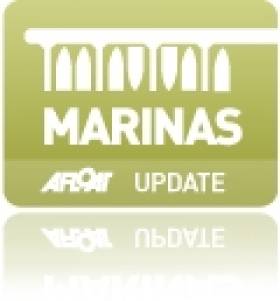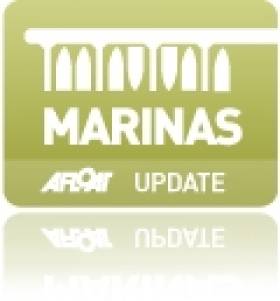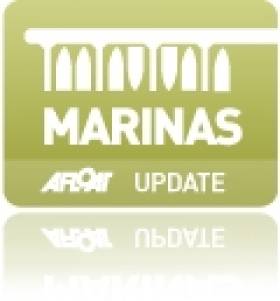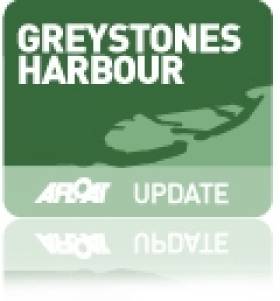Displaying items by tag: Marina
Greystones Harbour Marina to Open Next April with 100 Berths
#greystones – Greystones Harbour Marina in County Wicklow is to open next April with 100 berths.
The newest addition to boating on Ireland's east coast will be operated by BJ Marinas Ltd, a company owned by senior marine industry figure Bernard Gallagher.
The firm will operate the marina and boatyard on the purpose built site under contract from developers Sispar and Wicklow County Council.
"We're delighted to be appointed as harbour and marina operators for Greystones. It's a unique and stunning site and we're looking forward to opening this new marine leisure facility next April in time for the 2013 boating season" Gallagher told Afloat.
Gallagher's sister company BJ Marine Ltd is one of the most successful boat sales and service firms in Ireland established over 35 years. The firm represents some of the biggest names in global boating brands including French yacht manufacturing giant Beneteau for over 20 years. The firm also represents American power boat firm Sea Ray and British luxury motorboat manufacturer Fairline. In 2012 BJ Marine imported the first production hybrid diesel electric boat, the Slovenian built Greenline 33, into Ireland.
Although the substantial structure of the new Greystones breakwaters and harbour has been completed with two new slipways and part opened to the public for over a year the marina element had stalled during the financial crisis with only limited access to the new harbour for visiting boats.
Last March a meeting of local boat owners in the Wicklow town heard of 'huge interest' in the new facility and it is understood over 70 applications for berths were received.
BJ Marinas Ltd will be responsible for the installation of the marina. The marina furniture and piling will be 100% Irish built and supplied according to Gallagher.
Berths will eventually reach 230, a major bonus for the east coast boating scene.
Gallagher also operates Bangor Marina boatyard on Belfast lough. The company also has offices at Malahide marina in North Dublin and has operated an international base in Malta since 1989.
His interest in a marina at the harbour at Greystones goes back 16 years when entrepreneur Albert Gubay launched a plan for a 300-berth marina in 1996 that was never built.
The latest Greystones Harbour Project originally envisaged a primary care medical centre, some five new clubhouses for existing harbour users, a Coast Guard house, as well as commercial, leisure and office facilities, a new beach and some 375 new homes.
The project is a major Public Private Partnership involving Wicklow County Council and Sispar and expected to cost in excess of € 300 million. The land side of the development had stalled with the financial crisis.
Sisk builders announced in July that it had agreed with its partners Park Developments and their bankers NAMA that Sisk will take ownership and control of the project.
BJ Marinas Ltd have issued the following contact details for berth enquiries: [email protected] Telephone +353 (0)86 2718161
Waterford City Marina Earns Three Gold Anchor Award
#MARINAS – A third Irish marina on the South Coast has earned a Gold Anchor Award this season from the Yacht Harbour Association (YHA).
The small but modern Waterford city marina is located on the quays of Waterford on the river Suir joins Castlepark marina in Kinsale that earned four gold anchors in February and Royal Cork marina in Cork harbour that took the maximum five Gold Anchors from the YHA in the same month.
Waterford City Marina marina has over 100 berths with all relevant features and is fully owned and operated by the City Council, managed by superintendent Johnny Codd.
The city of Waterford has much to offer as visitors can view the surviving Viking city walls, various museums, shopping streets, a park, sports centre, golf course and much more. Lovers of history and arts will especially be thrilled by Waterford's sights.
The Gold Anchor scheme is a voluntary assessment programme which is focussed on customer service and providing quality berths for the boat owner. Ratings range from one to five Gold Anchors and provide assurance of quality and credibility of the marina. Qualifying technical criteria is based on TYHA's Code of Practice for the Construction and Operation of Marina and Yacht Harbours.
The BMF have more on the story.
Fishguard Marina Gets Green Light as 450-Berth Plan Approved
#MARINA NEWS - Outline planning permission has been granted for a new 450-berth marina in Fishguard, according to BBC News.
An 80-acre site comprising much of the south side of the harbour, near the Stena Quay used for ferry services across the Irish Sea to Rosslare, will be home to the new development that will also include 250 apartments and a number of shops and restaurants, and is expected to make a "significant" contribution to the local economy.
A light industrial area with a boatyard and workshop are part of the plans, as well as two breakwaters to protect the development from waves in Fishguard Bay.
The marina scheme will also feature a visitors centre, after discussions with local community conservation group Sea Trust and other parties.
Local politicians and business leaders are supportive of the scheme's potential to generate jobs and tourism. But residents have expressed concern at the scale of the development, fearing it will create an "enclave" for the boating community that will not be integrated with the town proper.
BBC News has more on the story HERE.
Marine Minister Officially Opens Cork Harbour Marina
An 88-berth Cork Harbour Marina located in Monkstown was officially opened on Saturday (7th of April) by Minister for the Marine, Simon Coveney, TD.
Phase one of the planned 300-berth marina facility in Monkstown Co. Cork, aptly named 'Cork Harbour Marina', is Ireland's newest coastal marina and is offering all year round berthing facilities for pleasure craft.
The new addition to the seaside village is in a sheltered location on the western bank of the River Lee in an area very popular for boating activities.
The bustling ceremony was also attended by Lord Mayor of Cork County, Michael McGrath of Fianna Fail, members of Monkstown Bay Sailing Club puls a number marine industry figures including John Wallace of Union Chandlery and Afloat.ie correspondent Tom MacSweeney.
As part of the proceedings the Irish Marine Federation's Steve Conlon saluted the tenacity of developer James O'Brien on completing the project. Steve Conlon's address gave a potted history to the new facility and we reproduce it here as an over view of the potential value of marinas to coastal communities:
I first met James some 8 years ago and I know how many hurdles he has crossed to get to this day, between planning, foreshore, State Valuation Office and the banks. These are just some of the impediments that are put in the way of would be developers who are putting in place valuable pieces of our tourism infrastructure. Marinas are sustainable developments, which will bring economic benefits to this area not only from resident boats but also from visitors.
From our own research we have established that the average spend per boat on a marina is in the region of €6,400 per annum. This is sum is made up of marina fees, insurance, training, sails, engine maintenance and chandlery spend.
An 88 berth marina, such as this one, has the potential to generate over €563,00.00. per annum in local economic activity. In addition our research shows that visiting boats spend on average almost €200 per night in the local community. Most of this money stays within the community. Our research also informs us that for every 2.7 marina berths, they support 1 full time job either in the marina itself or in associated business.
Stand alone marinas, like this one, are fine but they can become a real economic driver for an area when they begin to attract associated businesses into a Marine Industry Cluster of activity, such as boat sales, sailing and diving schools or bases for charter operations for deep sea angling and eco tours.
In terms of the marine leisure industry in Ireland it is worth in excess of €900 million per annum and accounts for 7% of our national tourism spend. Yet our national boat ownership ratio is low at 1 boat to every 156 people. Lots of room for expansion and development!
When you consider these figures and you realise what we have in terms of a natural resource on our doorstep, marina leisure tourism has the potential to deliver far more than it is in terms of international marine based visitors. We would like to see more incentives and promotional programmes put in place to encourage more overseas boat owners to base their boats in Ireland for at least two seasons to experience what we have on our South and West coast. To do this, however, we would need many more facilities such as this.
When you look at the global figures for marine activities, marine leisure tourism is the second most important economic activity after transport and shipping. It also accounts for 26% of the total global tourism product spend. The number one tourism product is cultural and heritage tourism at 27% of total global tourism. With our natural resources Ireland could become the marine leisure centre of excellence if it were to be developed in a sustainable way.
However, I am glad to say that attitudes are changing.
For the past 10 years the Irish Marine Federation has been calling for a National Integrated Marine Plan for Ireland, this request now seems to on the way to be answered.
There is one other person here to day I wish to thank and that is Minister Coveney. While he was in opposition he worked continually to promote the marine even when he did not have the portfolio.
We were delighted to see that he managed to incorporate Marine into his Ministerial title.
Through our involvement in ITIC, the Irish Tourist Industry Confederation I happened to meet Leo Varadka on the day that he was appointed as Minister of Transport, Tourism and Sport and I asked him if I could come to see him regarding marine leisure tourism, his reply was, yes, certainly but Simon Coveney is going to do something in that area.
I also know from my ongoing contacts with Failte Ireland that both the Minister Coveney and Minister Varadka met with Failte Ireland to discuss progress on the development of a marine leisure tourism strategy.
So on behalf of the marine industry in Ireland we would today like to congratulate both James O'Brien on the official opening of his marina and look forward to future developments on this site and also Minister Coveney for his work in promoting the marine industry in Ireland.
Berth bookings now being taken on 087 3669009.
Castlepark Marina Awarded Four Gold Anchors
#MARINAS – In a month when Royal Cork marina in Crosshaven was rewarded for its efforts by the Yacht Harbour Association another Munster marina, Castlepark marina in Kinsale has also been granted an award under the internationally recognised marina standards scheme.
Situated on a small peninsula in the estuary of the river Bandon and Kinsale only 20 minutes from Cork International Airport, Castlepark marina can pride itself in receiving 4 Gold Anchors from The Yacht Harbour Association. It is a great achievement for the town and the area but also for Tadgh Wright who has managed the marina for the past six years.
With 98 berths, the marina is kept clean and tidy, and set in beautiful surrounding countryside with the old James Fort overlooking the marina; 'a perfect place for those sailors looking for peace and tranquillity', says Wright.
"The greatest 'perk' of my job is welcoming many a sailor to Castlepark Marina over the years, showing off our unrivalled country side location just outside one of Ireland's finest towns with award winning restaurants and bars" says Wright.
Kinsale is a focal point to the most incredible cruising grounds Europe has to offer, to the famous Fatnet Rock and beyond the South West coast of Ireland is a not to be missed experience.
The YHA assessors praised Wright for delivering an excellent, personal service to his berth holders and keeping his marina in excellent condition.
Royal Cork Marina Wins Five Anchor Award
Royal Cork Yacht Club's marina has been awarded five gold anchors by the Yacht Harbour Association and becomes the fourth facility on the coast of Ireland – and the only one on the south coast – to win the distinction.
The 200 berth facility on the Owenabue river in Cork harbor joins Dun Laoghaire marina, Carrickfergus marina and Bangor marina on the east coast with the five anchor flag.
There are over 25 coastal marinas in Ireland and the facilities are key to providing marine tourism revenues from visiting yachts and boats.
The award follows two major reports that recognise that Cork's long and varied coastline is one of its greatest assets. The Mayor of Cork County, Councillor Kevin Murphy, and the County Manager, Martin Riordan, launched two major reports on Cork's coastal areas last Summer; a Marine Leisure Strategy for South Cork, and a Draft Study of Cork Harbour.
The Marine Leisure Infrastructure Strategy for South Cork, 2010-2020 is a document that has paved the way for additional marine leisure facilties to get established in the harbour.
Royal Cork also picked up an International Council of Marine Industry Associations (ICOMIA) Clean Marina during a recent inspection.
The awards are a short in the arm for the world's oldest yacht club who debated the future direction of the club at its annual forum last November. The club are preparing for its 400-boat biennial Cork Week 2012 regatta this July.
The Gold Anchor award scheme is a voluntary assessment programme focused on customer service and providing Quality Assured Berthing for any boat owner. The scheme is designed for the marina consumer by The Yacht Harbour Association with contribution from the Roysl Yachting Assocation. With 23 years experience of Gold Anchor standards, the award is a point of reference for all boat owners to make an informed decision on where to berth.
Work Begins to Eliminate Sea Squirts in North Wales
#MARINE WILDLIFE - Work on exterminating sea squirts at a marina in north Wales has begun.
The £250,000 (€301,000) project by the Countryside Council for Wales involves attaching giant bags to the subsurface structures around the marina in Holyhead, which is hoped will stop the clean flow of water to the sea squirts, causing them to suffocate and die.
Marine biologist Rohan Holt, who is managing the project, said: “If we successfully eradicate the sea squirt, we will work hard to make sure that it does not recolonise.
"This will mean careful monitoring in Holyhead marina and other marinas and popular mooring areas throughout Wales to check that it hasn’t reappeared."
The sea creature threatens shellfish by spreading like a blanket across the seabed and other surfaces.
As previously reported on Afloat.ie, colonies of the invasive Japanese sea squirt are posing a throat to mussel and scallop bed in the Menai Strait between Anglesey and the mainland.
Boats from Ireland have been blamed for carrying the invasive pest into Holyhead.
The Daily Post has more on the story HERE.
New Study for 200–Berth Marina at Portush Harbour
#PORTRUSH – A study of Portrush harbour in County Antrim is being carried out to investigate the feasibility of creating a marina facility of up to 200 berths in the Northern port. The study is sponsored by the Sail West project which aims to promote sailing tourism between the west of Scotland and Northern Ireland and Donegal. The small harbour at Portrush is usually busy with small pleasure and fishing boats in the summer season. The nearest marina to Portrush is the 74-berth Ballycastle marina, 17 kms away, that is in full use by local fisherman and yachtsmen alike.
View Larger Map
Permanent Jet Ski Berths Launched in Poole Marina
#JETSKI–A new marina in Poole has launched a specialist area for jet skis.
The Port of Poole Marina in Dorest, which enjoys views of Brownsea Island and is close to the historic Poole Quay, is offering 13 permanent berths for jet skis.
John Binder, marina manager, said: "The hassle of storing a jet ski at home, towing it by car, paying to launch it at Baiter Park and having to head home to shower afterwards can detract from the fun of a day on the water. Our new facility offers jet ski owners a place to store their craft, with immediate access to the open sea and a chance to shower and enjoy the local social scene afterwards."
Among those to use the site to store his jet skis is Arran Scott, Principal of Absolute Aqua watersports academy. He said: "The new marina is perfect for us. Until now we've had to store boats further away and our lessons started with a frustratingly slow trip to open sea through areas with a restricted speed limit. Now we're right by the open sea, there's no wasted time, we can park on site and the facilities are excellent."
The marina, which opened this year, was constructed by Walcon Marine (the company behind the marina at the Dubai International Boat Show). It occupies the former Ro-Ro1 Brittany Ferries berth and offers on site toilets, showers and parking and a free water taxi service to nearby Poole Quay.
As well as berths for ribs and jet skis, it houses 59 boats between 10 and 15 metres in length and has visitor berthing for up to six deep-draught super yachts.
Progress on Greystones Marina 'Slower than Hoped'
#MARINA – Inspite of the recent positive news about the opening of the interim harbour at Greystones there is still no more no more definite news on the planned marina there.
Developers Sispar, with assistance from Greystones Sailing Club, Greystones Motor YC and local Councillors are putting together a list of prospective users together with a view to holding a meeting to assess whether there is enough demand to justify putting pontoons down for next Summer's boating season. 'Progress on this has been slower than hoped', Councillor Derek Mitchell told Afloat.ie




































































